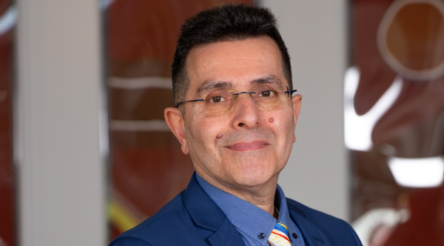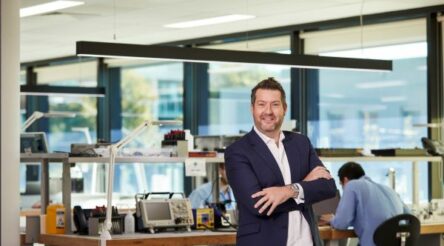Mighty white: finding the right market for a supermaterial

In the latest profile of a nominee for our Australia’s 50 Most Innovative Manufacturers list, we learn about White Graphene. WG was founded in 2020 to commercialise production technology developed at Deakin University for a promising 2D material. Brent Balinski speaks to the company’s Lieuwke de Jong.
Graphene – with its host of superlative attributes – created a lot of excitement after it was first synthesised in 2004, then after the pair responsible won a Nobel in 2010. After a while, articles started to appear lamenting a lack of commercial impact or a “killer app”.
It has found its way into some useful applications – and products like GMG’s graphene aluminium-ion batteries might be hugely successful in future – but few would argue graphene has changed the world yet.
White Graphene makes a material described as analogous to regular graphene, with “two-dimensional” layers of hexagonally-arranged atoms, though is based on boron rather than carbon.
Like their near-namesake, boron nitride nanosheets AKA white graphene come with a swag of potentially useful properties.
According to White Graphene — a joint venture between PPK Group and Deakin University — their nanosheets are 138 times stronger than 304 grade steel, have a massive surface area, and have demonstrated big antibacterial, antifouling, wear resistance and other benefits at low loadings in coatings.
“The holy grail for the past 30, 40 years has been how do you scale up the manufacturing of boron nitride nanomaterials, because when you look at our competitors, they’re only capable of manufacturing grams. Grams per month,” Lieuwke de Jong, Commercial Director at PPK Group, tells @AuManufacturing, adding that this has made prices prohibitively expensive.
 “[We have solved] the mystery around mass production of high-purity, low-variability white graphene.”
“[We have solved] the mystery around mass production of high-purity, low-variability white graphene.”
White Graphene, which is a sister company to boron nitride nanotube business BNNT Technology, has been able to up output from a single gram per week to five kilograms, with capacity to scale up to 20 kilograms if needed, de Jong says.
The two-year R&D project between the company and Deakin University scientists is being put forward by White Graphene for @AuManufacturing’s Australia’s 50 Most Innovative Manufacturers campaign.
Besides markets including gelcoats for marine users and timber coatings, White Graphene has its sights set on the emerging hydrogen market.
With their impermeability to hydrogen, boron nitride nanosheets could provide an answer to the gas’s potential to attack the integrity of steel pipes and welds.
“If you transport it through a pipeline, for instance the current gas pipeline infrastructure, the problem is that it permeates through the pipeline, through the steel, and even worse you can get steel embrittlement,” says de Jong.
“Now if you mix the white graphene with certain coatings, we can actually make those pipelines, those steel pipelines, impermeable to the hydrogen gas. And that basically means that potentially you could use the existing infrastructure in a hybrid way, so you could either transport gas or you could transport hydrogen gas.”
Like its black counterpart, white graphene is at an early stage of adoption.
Manufacture of regular graphene appears to have some way to go, both to decrease costs and increase quality.
“[G]raphene produced using top-down methods is often many layers thick, has holes or deformations, and can contain impurities,” wrote Kevin Wyss from Rice University last year.
“Factories can produce a few tons of mechanically or chemically exfoliated graphene per year, and for many applications – like mixing it into plastic – the lower-quality graphene works well.”
De Jong says inconsistencies in graphene manufacture are something his company is working to avoid, and is confident they can do what regular graphene hasn’t been able to yet.
“I don’t want to come across as cocky, but graphene… 15, 20 years ago promised us a lot of things. And some of those have definitely materialised,” he explains.
“Don’t get me wrong, graphene is a fantastic material, but there are definitely some shortcomings. And my belief, my feeling is that white graphene will actually deliver on the promises that graphene did not deliver on.”
In this episode of @AuManufacturing Conversations with Brent Balinski, de Jong tells us about the remarkable properties of boron nitride nanosheets, which are being produced in what he says are world-leading quantities in Australia. Like any new super-material, they’re just looking for the right market.
Episode guide
1:22 – Introduction to de Jong and White Graphene.
2:28 – Boron nitride nanosheets – “the 2D polymorph of boron nitride” – and what they can do as an additive.
3:38 – Volumes being made currently.
5:30 – Current focus with applications.
6:44 – The understanding of innovation at the company. ”To us innovation means developing unique products that have a meaningful impact on the products and services of our customers and thus contribute to a better tomorrow.”
7:35 – Innovating at a business-to-business company, and why de Jong believes white graphene will be more successful than regular graphene.
9:25 – Electronics and the advantage of white graphene over graphene.
9:55 – Working with the team at Deakin University’s IFM led by Associate Professor Luhua Li.
11:30 – Customer-led R&D and functionalisation of nanosheets.
14:20 – New projects around validation and the potential – and challenges – of the rising hydrogen industry.
17:02 – The volatility of energy prices and why it matters to White Graphene.
Further reading
THREE BUSINESSES FROM A SINGLE ENTREPRENEURIAL COMPANY GET FEDERAL GRANTS
PPK AND DEAKIN TO DEVELOP THIN-FILM WHITE GRAPHENE
PPK GROUP’S DIFFICULT TRANSITION TO BE A TECHNOLOGY COMPANY
Is you company one of Australia’s 50 most innovative manufacturers? We want to hear from you.
PUT YOURSELF FORWARD AT THIS LINK. NOMINATIONS CLOSE AT 5 PM (AEST) ON MAY 26.
WATCH OUR LAUNCH WEBINAR HERE.
![]()
Australia’s 50 Most Innovative Manufacturers is a new campaign by @AuManufacturing. It has been made possible by the generous support of MYOB, SMC Corporation Australia, and Bosch Australia Manufacturing Solutions. Be sure to check back at this website for regular updates including profiles of nominees and other information.
Topics Analysis and Commentary
@aumanufacturing Sections
Analysis and Commentary Awards Defence Manufacturing News Podcast Technology Videos










